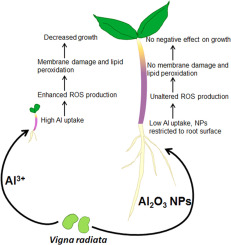Ecotoxicology and Environmental Safety ( IF 6.2 ) Pub Date : 2018-09-13 , DOI: 10.1016/j.ecoenv.2018.09.033 Nisha Shabnam , Hyunook Kim

|
Wide use of Al2O3 nanoparticles (NPs) leading to their possible escape into environment and their interaction with living organisms demands immediate attention. We evaluated impact of nanoparticulate (Al2O3-NPs) and ionic (Al3+) forms of aluminium on early seedling growth of Vigna radiata. While Al3+ inhibited growth of seedlings, Al2O3-NPs did not affect it negatively. Unlike enhancement in proline, malondialdehyde and H2O2 levels in roots and shoots induced by Al3+, these stress markers remained unaltered by Al2O3-NPs. No signs of membrane damage were recorded in roots of seedlings raised in presence of Al2O3-NPs; this was witnessed from insignificant electrolyte leakage and Evans blue uptake. Activities of antioxidant enzymes, i.e., superoxide dismustase, catalase, guaiacol peroxidase in root and shoot were enhanced by Al3+. However, they were unaffected by Al2O3-NPs. Al3+ enhanced levels of non-protein thiols, phenolics and ascorbate, with no alterations induced by Al2O3-NPs. These findings revealed that, Al2O3-NPs did not induce oxidative stress in seedlings. Seedlings raised in Al3+ showed higher uptake of Al than those grown in Al2O3-NPs; Al content was higher in roots. Al was not detected in shoots of seedlings grown in Al2O3-NPs. Lower translocation of Al in seedlings raised in Al2O3-NPs was due to adsorption/restriction of Al2O3-NPs on root surface. Al3+ caused ruptures on root epidermis of seedlings and inhibited root-hair formation, whereas no structural damage was caused by Al2O3-NPs. Our findings revealed that while ionic Al is highly toxic, nanoparticulate form of Al is non-toxic to growth of V. radiata.
中文翻译:

纳米氧化铝的无毒性-以绿豆幼苗为例
Al 2 O 3纳米颗粒(NPs)的广泛使用导致其可能逃逸到环境中以及与生物体的相互作用需要立即引起注意。我们评估了铝的纳米颗粒(Al 2 O 3 -NPs)和离子(Al 3+)形式对Vigna radiata幼苗早期生长的影响。尽管Al 3+抑制了幼苗的生长,但Al 2 O 3 -NPs并未对其产生负面影响。不同于增强脯氨酸,丙二醛和H 2级Ø 2水平由铝诱导根与芽3+,这些应激标志物的Al保持不变2O 3 -NP。在Al 2 O 3 -NPs存在下生长的幼苗的根中没有记录到膜损伤的迹象。从微不足道的电解液泄漏和埃文斯蓝色吸收可以看出这一点。Al 3+增强了根和茎中抗氧化酶(超氧化物歧化酶,过氧化氢酶,愈创木酚过氧化物酶)的活性。然而,它们不受Al 2 O 3 -NP的影响。Al 3+增强了非蛋白质硫醇,酚类和抗坏血酸的水平,而Al 2 O 3 -NPs没有引起任何改变。这些发现表明,Al 2 O 3-NP在幼苗中不诱导氧化应激。在Al 3+中生长的幼苗比在Al 2 O 3 -NPs中生长的幼苗对铝的吸收更高。根中的铝含量较高。在Al 2 O 3 -NPs中生长的幼苗的芽中未检测到Al 。Al 2 O 3 -NPs引起的幼苗中Al的较低转运是由于根表面上的Al 2 O 3 -NPs吸附/限制。Al 3+引起幼苗根表皮破裂,抑制根毛形成,而Al 2 O 3则不引起结构破坏-NP。我们的发现表明,尽管离子型Al具有高毒性,但Al的纳米颗粒形式对辐射弧菌的生长无毒。











































 京公网安备 11010802027423号
京公网安备 11010802027423号